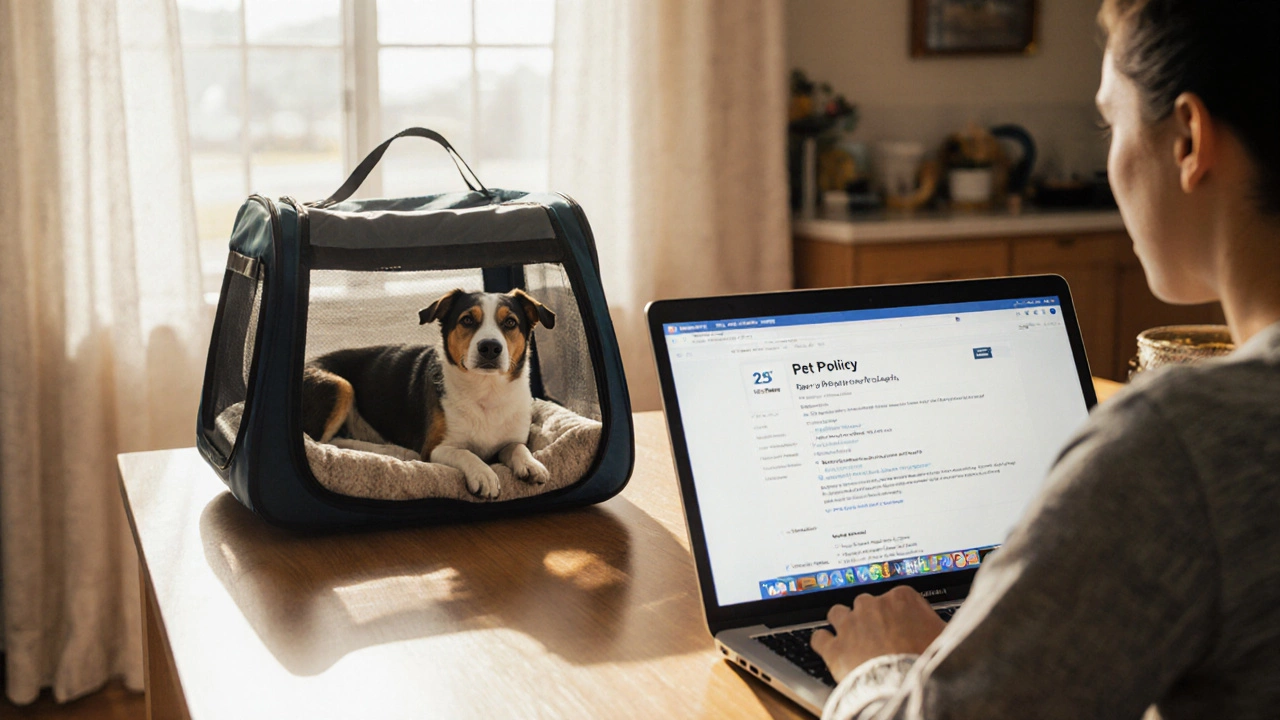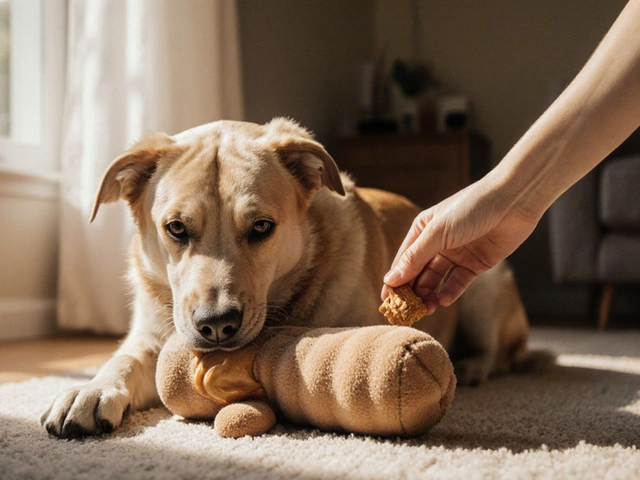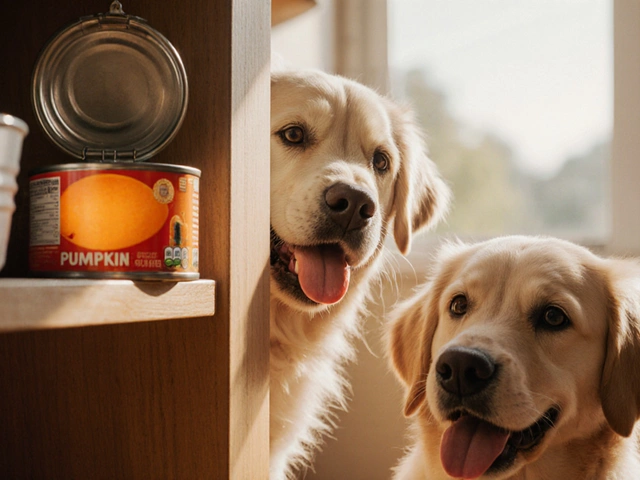Dog Travel Option Calculator
Travel Options Calculator
Find out if your 25-lb dog can travel in the cabin or must go in cargo based on your travel specifics.
Results
Wondering whether your 25‑lb companion can hop on a plane with you? The short answer is yes-most major airlines allow a dog of that weight to travel, but the details vary a lot. From cabin size limits to cargo‑hold temperature controls, every airline has its own checklist. This guide breaks down everything you need to know so you can book with confidence, keep your pup safe, and avoid surprise fees at the gate.
Key Takeaways
- Most airlines treat dogs up to 22‑25lb as cabin‑eligible if the carrier fits under the seat.
- Cabin fees usually range from $75USD to $150USD; cargo fees are higher and depend on weight and distance.
- Required documents include a recent health certificate and proof of vaccinations.
- Choosing the right carrier (soft‑side vs. hard‑shell) can make the difference between a smooth flight and a denied boarding.
- Pre‑flight conditioning-short practice trips, hydration, and soothing gear-helps reduce stress for both you and your dog.
Below, we’ll walk through the exact steps you need to take, the common pitfalls to dodge, and a handy comparison table that lets you decide whether the cabin or cargo hold is the better fit for your 25‑lb dog.
Understanding Airline Weight and Size Limits
Every carrier must fit under the seat in front of you. The typical maximum dimensions are about 18×11×9in (45×28×23cm), but some carriers are slightly larger if the airline permits a “large pet” category. Dog is a mammal kept as a companion animal, and a 25‑lb adult dog falls into the medium‑size range, meaning most carriers designed for “small dogs” will accommodate it. If your carrier exceeds the limit, you’ll be forced to ship the dog as cargo, which involves additional paperwork and costs.
Cabin vs. Cargo: Which Is Right for a 25‑lb Dog?
| Factor | Cabin | Cargo (Temperature‑controlled) |
|---|---|---|
| Weight limit | Typically ≤22‑25lb (varies by airline) | Up to 100lb or more, depending on crate size |
| Carrier size | Must fit under seat (≈18×11×9in) | Sturdy hard‑shell crate, usually 24‑30in long |
| Cost (US domestic) | $75-$150, one‑way | $200-$500, plus possible handling fees |
| Temperature control | Cabin climate‑controlled (23‑24°C) | Specialized cargo holds with 7°C-30°C range (some airlines restrict extreme weather) |
| Stress level | Dog stays with owner, less anxiety | Separated from owner, higher stress |
| Legal restrictions | Often allowed on most domestic routes | Some international routes limit live animals in cargo during summer |
For most owners, the cabin option feels safer and cheaper, but it’s only viable if your carrier meets the airline’s dimensions. If you’re traveling internationally or on a low‑cost carrier with tighter rules, cargo may be the only route.
Essential Documents and Health Checks
Airlines won’t let you board without a valid health certificate. This is a document signed by a licensed veterinarian stating that your dog is fit for travel and up‑to‑date on vaccinations. Most airlines require the certificate to be issued within 10days of departure; some (especially for international flights) demand a 5‑day window.
- Rabies vaccination proof - required by virtually every country.
- Canine influenza or other regional disease certificates if you’re heading to places with strict bio‑security.
- Microchip registration number - many nations demand an implanted microchip that complies with ISO11784/11785.
Don’t wait until the last minute. Schedule a vet visit at least two weeks before travel, get the health certificate, and ask the vet to write a brief “travel‑ready” note that includes any medication your dog needs.
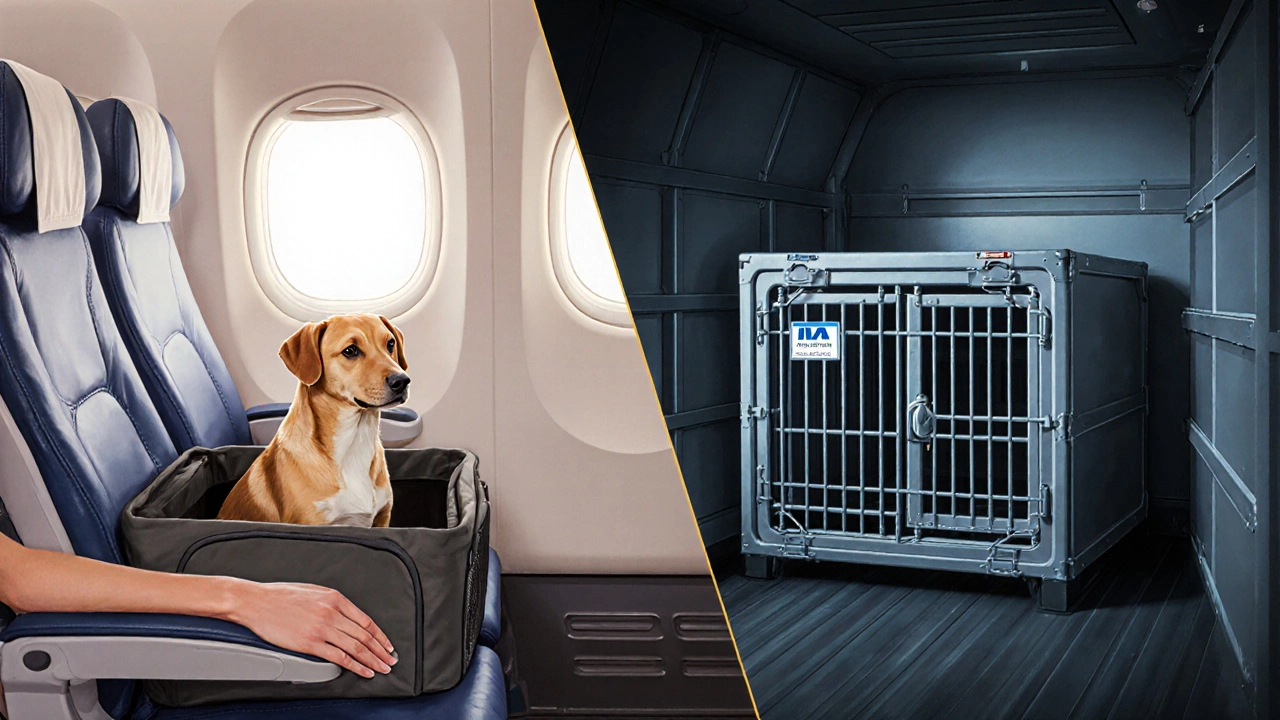
Booking the Flight: Steps to Secure Your Spot
- Check the airline’s pet policy on their website. Look for “pet‑in‑cabin weight limit,” “carrier dimensions,” and “seasonal restrictions.”
- Call the airline’s reservation center to confirm availability. Some carriers limit the number of pets per flight (often 5‑7).
- Reserve your dog’s spot when you book the ticket. Most airlines add a pet fee at this stage; you’ll receive a confirmation number for your pet.
- Upload or email the health certificate and vaccination records as instructed.
- Arrive at the airport early-at least 2hours before domestic flights and 3hours for internationals-to complete check‑in paperwork for your pet.
If you’re flying with a budget airline, be prepared for a higher likelihood of a “pet‑not‑allowed” message, as they often charge extra for pets and have stricter limits.
Choosing the Right Carrier
Two main styles dominate the market: soft‑side and hard‑shell. Soft‑side carriers are lightweight and often airline‑approved for cabin travel, but they offer less protection if placed in cargo. Hard‑shell crates meet International Air Transport Association (IATA) standards for cargo hold, providing sturdy ventilation and a secure latch system.
- Soft‑side carrier - Ideal for cabin travel. Look for breathable mesh, a top opening, and a sturdy base. Ensure it’s labeled “airline‑approved.”
- Hard‑shell crate - Required for cargo. Must be at least 2in of clearance on all sides, have secure locking mechanisms, and be labeled with the airline’s IATA code.
Measure your dog’s length from nose to tail tip, then add 2‑3in to each side for comfortable movement. A 25‑lb Labrador‑type dog typically needs a crate about 24×18×18in.
Preparing Your Dog for the Flight
Stress is the biggest enemy of a successful trip. Here are proven tactics to keep your pup calm:
- Acclimate to the carrier - Place the carrier in your living room, add a familiar blanket, and feed treats inside. Do this for a week before travel.
- Exercise beforehand - A brisk walk or play session an hour before the flight burns excess energy.
- Hydration, not over‑feeding - Offer water right up until the security checkpoint, but limit food to a small meal 4hours before departure to avoid nausea.
- Calming aids - If your dog gets anxious, discuss pheromone sprays or low‑dose sedatives with your vet. Never give human medication.
- Identify the pet - Attach a tag with your name, phone, and flight number. A brief note inside the carrier with “If found, please contact” can be a lifesaver.
What Happens at the Airport?
Security is a bit different for pets. You’ll place the carrier on the conveyor belt, and agents will scan it separately while you walk through the metal detector. If the carrier triggers the alarm, you may be asked to open it for inspection. Keep your dog on a leash and use a calm voice; the process usually takes only a couple of minutes.
Once you reach the gate, the flight attendant will confirm that the carrier is safely stowed under the seat. During take‑off and landing, keep the carrier upright and avoid opening it. Some airlines allow you to briefly take your dog out for a walk in the aisle, but that’s rare.
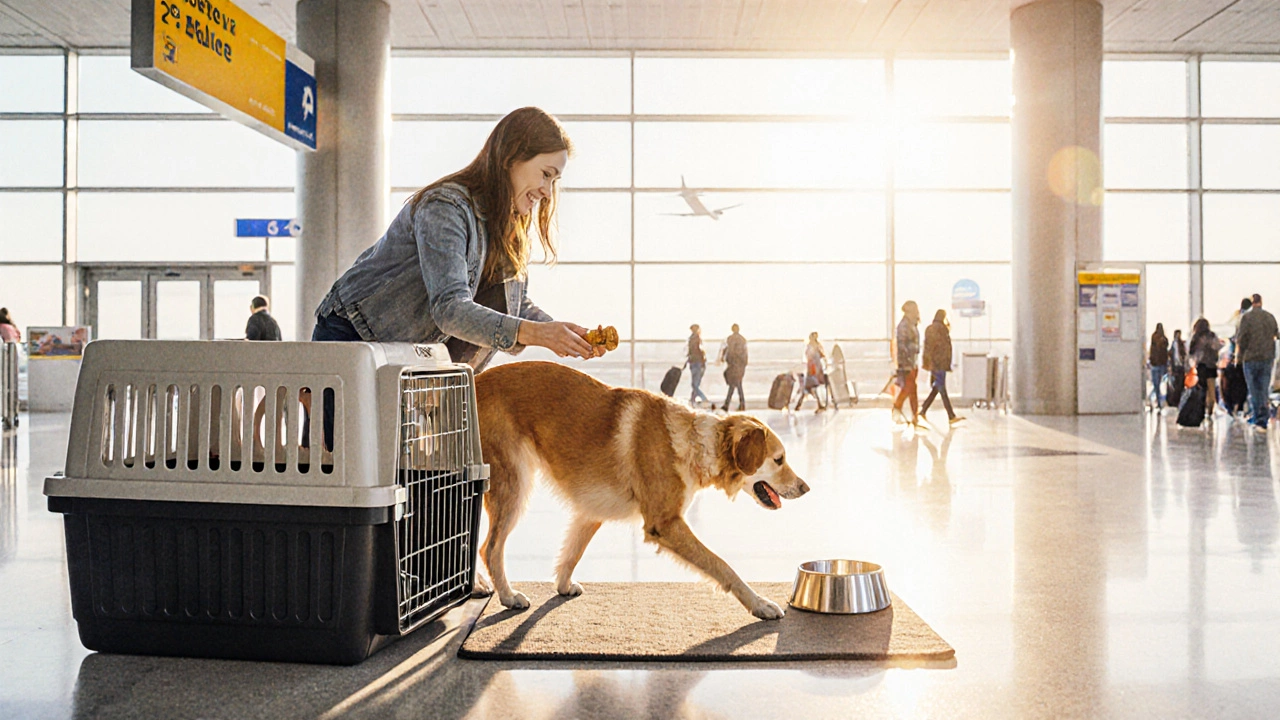
After the Flight: Arrival and Recovery
When you disembark, head straight to the pet‑relief area if the airport has one. Let your dog stretch, drink water, and go to the bathroom. If you used cargo, locate the animal‑handling area (often at baggage claim) and collect the crate. Check your dog for signs of dehydration, paw injuries, or stress‑related anxiety. A short walk and a favorite treat usually bring most dogs back to normal within an hour.
Common Pitfalls and How to Avoid Them
- Overlooking seasonal restrictions - Many airlines ban cargo pets when outside temperatures exceed 30°C or drop below -5°C. Check ahead during summer or winter trips.
- Assuming all airlines are the same - United, Delta, American, JetBlue, and low‑cost carriers each have unique policies. Don’t copy‑paste a checklist from a different airline.
- Forgetting the health certificate expiration - A certificate older than the airline’s limit will be rejected at the gate, causing costly re‑booking.
- Choosing the wrong carrier size - Too small leads to discomfort, too large means the carrier won’t fit under the seat and you’ll be forced into cargo.
- Neglecting pet insurance - Travel insurance that covers pets can reimburse unexpected veterinary costs if your dog falls ill en route.
By ticking off each of these items, you’ll turn a potentially stressful journey into a smooth adventure for both you and your four‑legged friend.
Quick FAQ
Frequently Asked Questions
Can a 25‑lb dog travel in the cabin on all airlines?
Most U.S. and European carriers allow dogs up to 22‑25lb in the cabin, but the exact limit and carrier dimensions differ. Low‑cost airlines often have stricter limits, so always verify the policy of the specific airline you plan to use.
What paperwork do I need for an international flight?
You’ll need a health certificate issued within 10days, proof of rabies vaccination, a microchip registration that meets ISO standards, and any destination‑specific disease clearances (e.g., EU pet passport, Australian import permit). Some countries also require a blood titer test for rabies.
Is it cheaper to fly my dog in the cabin or cargo?
Cabin fees are typically $75‑$150 one‑way, while cargo fees can start at $200 and rise sharply with distance and weight. Cabin travel also avoids the extra handling steps required for cargo, making it both cheaper and less stressful for most dogs.
How can I keep my dog calm during the flight?
Acclimate your dog to the carrier, give a light exercise before boarding, use a familiar blanket, and consider a vet‑approved calming pheromone spray. Offer water but limit food a few hours before take‑off to prevent nausea.
What if my flight is cancelled after I’ve paid the pet fee?
Most airlines will transfer the pet fee to the new itinerary without a refund. If you need a full refund, you’ll have to cancel the reservation within the airline’s refundable window, which often means paying a higher fare for the new ticket.
Ready to book that ticket? Remember, the most important factor is planning ahead-secure the carrier, gather the paperwork, and book early. With those boxes checked, you and your 25‑lb dog will be set for a safe, comfortable flight.
